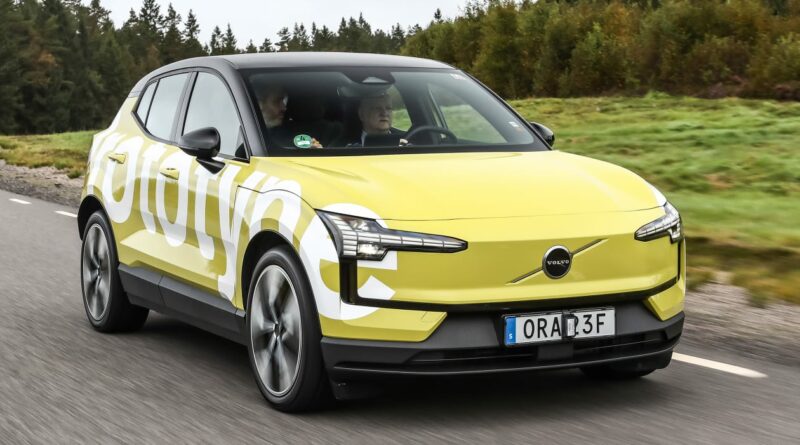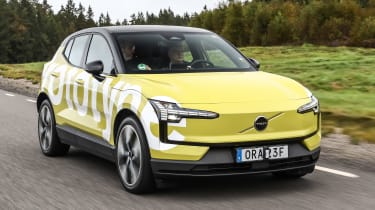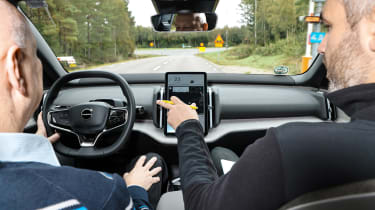New Volvo EX30 ride review
We hitch a lift in Volvo’s most important model for a decade; the new EX30 is a small electric SUV to rival the Jeep Avenger
Verdict
The price is very much right with this new Volvo EX30. The small SUV will win favour on cost alone, though from this short spell in the passenger seat it seems there is lots more to like. Quiet, quick, comfortable and composed, Volvo’s newcomer has the ingredients to succeed in a terribly tough area of the market. We can’t wait to try it ourselves in a few weeks’ time.
Big, expensive electric SUVs aren’t the cashcows people think they are. These halo products may draw in the crowds, but it’s the smaller, more affordable cars that make the money.
So while Volvo’s hotly-anticipated EX90 may demonstrate everything the brand is capable of right now, it’s the entry-level EX30 that’ll sell in bigger numbers. That’s especially true given the mini-Volvo’s sub-£34,000 starting price undercuts not only its electric rivals, but plenty of petrol SUVs with significantly higher whole-life costs, too.
But while prices and initial specs were announced earlier this year, first customer cars won’t arrive until February 2024. To see if those who’ve already placed an order will ultimately resent the wait, we’ve ridden shotgun in a dual-motor EX30 Twin, on a variety of roads at Volvo’s Hallered Proving Ground near its HQ in Gothenburg, Sweden.
Sitting alongside Egbert Bakker, technical lead for vehicle dynamics, we’re immediately taken to an area that the team refers to as the ‘English Road’ – a lumpy section of broken tarmac designed to mimic the unique surfaces found on our side of the Channel.
The EX30 feels composed. You can sense our test car’s 20-inch wheels fidgeting beneath you, but the damping is supple enough to take the edge off the worst bumps. The body does roll a bit through the corners, but no worse than other B-segment SUVs. “This is not supposed to be a sports car”, Bakker tells us.
Next up is the so-called ‘Florida’ section – featuring larger undulations as well as smaller ripples and potholes. Bakker uses it to demonstrate how quickly the EX30 resets itself after cresting a ramp, using the SUV’s extra ride height to absorb any unwanted longitudinal movement. It certainly appears tied down from the passenger seat, with Bakker assuring us that it feels even better from where he’s sitting. We’ll need to wait another month or so to see if that rings true.
To this point, we’ve only really been given a sense of the new EX30 from a comfort and refinement perspective. Hushed all the way to 70mph and beyond, this isn’t a car that’ll be confined to the city streets; even the base car gets a 212-mile range, while big battery models officially max out at 298 miles under official tests. The one we’re sitting in is showing almost 500km (310 miles) at 96 per cent state of charge.
Bakker then takes us to the handling circuit where we can up the pace and get a feel for how the car moves about under load. As technical lead, this man is responsible for all models from EX30 to EX90; it’s his job to ensure they share a series of attributes apparent in Volvo cars for the past six decades.
Acceleration from our Twin Performance test car catches us unawares at times – from a standstill right up to motorway speeds. The straight line speed isn’t as gut-wrenching as in a (admittedly larger) Tesla Model Y, but we can’t help but feel the more linear power delivery is likely to suit more people, more of the time.
Elsewhere, Bakker – as well as EX30 product lead Joakim Hermansson – insist the minimalist cabin layout is easy to get used to. “It felt unusual at first”, Hermansson tells us, “but within 500 metres it was normal.” There is no conventional instrument cluster, with the speed readout sitting above the navigation and media controls on the central screen. The high-set display puts the key information closer to your natural eyeline than a Tesla might, though we’d need to spend some time behind the wheel before casting a definitive verdict.
General fit and finish is easily a match for cars at this price point, even as a late-stage prototype. Indeed, the myriad recycled finishes for the dashboard, seats and even the floor mats, will give customers both a clean conscience and a premium feel – even if trading down from, say, an XC60.
Accommodation is another plus point. Despite its size, a six-foot adult can sit behind a similarly-sized driver, and while the 318-litre boot may sound small, it didn’t look any more compromised than the class average. Storage under the bonnet means you don’t need to contend with loose charging cables, either.
As we’ve already hinted, the entry price is eye-catching. Available in Plus and Ultra specs at launch, a Core variant of the single-motor car will join the range soon, priced from around £31,500. As with Volvo’s range of electric XC40s, it’s the mid-spec Plus that is likely to be the sweet spot, mixing a competitive standard kit list for a reasonable initial outlay.
| Model: | Volvo EX30 Twin Performance Ultra |
| Price: | £44,495 |
| Powertrain: | 64kWh battery, 2x e-motors |
| Power/torque: | 422bhp/543Nm |
| Transmission: | Single-speed auto, four-wheel drive |
| 0-62mph: | 3.6 seconds |
| Top speed: | 112mph |
| Range: | 286 miles |
| Charging: | 175kW, 10-80% in 27 mins |
| On sale: | Now |
Source: Read Full Article







